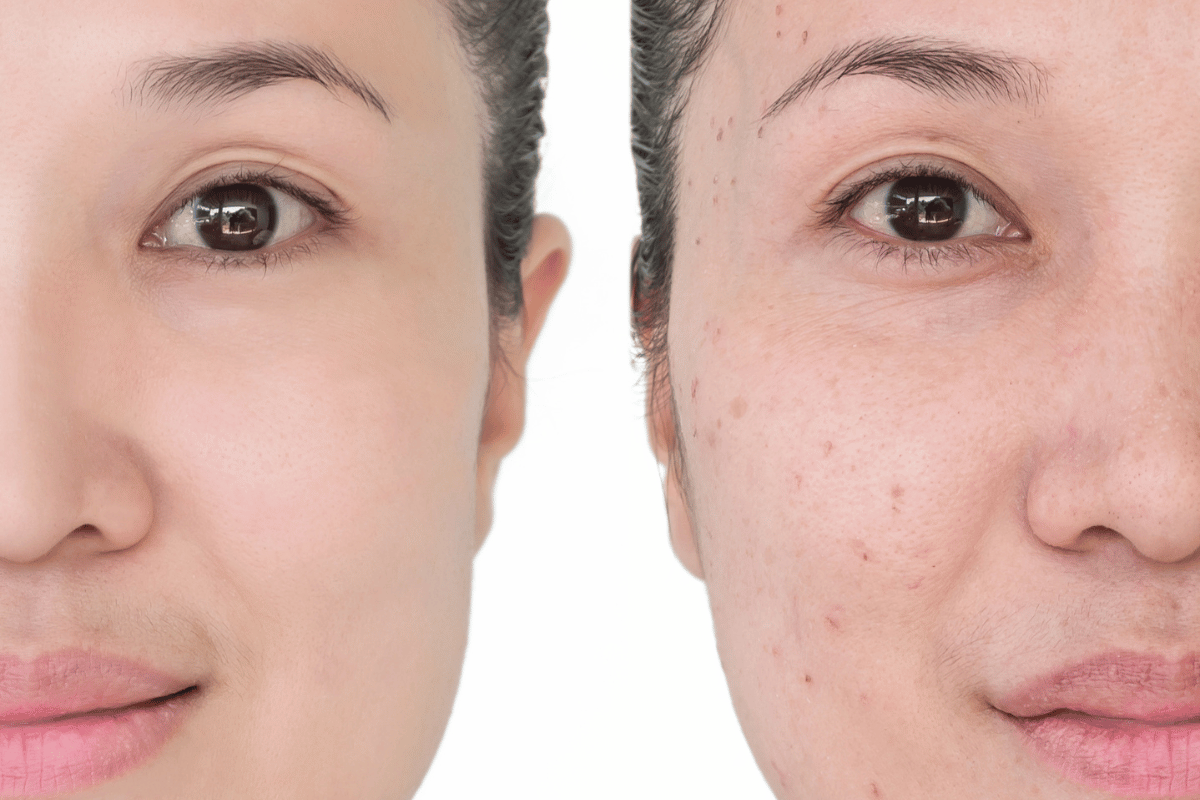Skin tags are small growths that appear on the surface of the skin. They are typically benign and harmless, but they can be a cause for concern when they appear in certain areas of the body, such as the armpit. Skin tags in the armpit can be particularly uncomfortable and unsightly, and it’s important to understand their causes, symptoms, and treatment options.
Causes of Skin Tags in the Armpit
Genetics and Family History
Genetics and family history are thought to be one of the main factors that contribute to the formation of skin tags, including those that appear in the armpit. If someone in your family has skin tags, you may be more likely to develop them as well.
Friction and Irritation
Friction and irritation can also play a role in the formation of skin tags in the armpit. This is especially true for individuals who wear tight clothing or engage in activities that involve a lot of arm movement. The constant rubbing of the skin can cause small tears, which can lead to the development of skin tags.
Hormonal Changes
Hormonal changes, such as those that occur during pregnancy or menopause, can also contribute to the formation of skin tags in the armpit. Changes in hormone levels can cause an increase in skin growth, which can lead to the formation of skin tags.
Obesity and Weight Gain
Obesity and weight gain can also contribute to the formation of skin tags in the armpit. This is because excess fat can cause folds of skin to form, which can rub against each other and lead to the development of skin tags.
Other Medical Conditions
Certain medical conditions, such as insulin resistance, can also increase the likelihood of developing skin tags in the armpit. Individuals with this condition may have an increased number of skin tags, including those that appear in the armpit area.
Understanding the various causes of skin tags in the armpit can help individuals take steps to prevent their formation or seek appropriate treatment if necessary.

Symptoms of Skin Tags Armpit
Skin tags in the armpit can vary in appearance and size, but they typically appear as small, soft, flesh-colored growths that hang off the skin. They may be round or irregularly shaped, and can range in size from a few millimeters to several centimeters.
While skin tags are usually painless, they can cause discomfort or irritation if they become irritated due to friction from clothing or movement. In some cases, skin tags may also become inflamed, swollen, or painful.
Changes in color or texture are less common with skin tags in the armpit, but it is still important to monitor any changes in the appearance of the skin tag. If the skin tag becomes darker in color, begins to bleed or change in texture, it is important to seek medical attention to rule out any underlying health concerns.
That while skin tags in the armpit are usually harmless, any unusual or concerning symptoms should be evaluated by a healthcare professional to ensure proper diagnosis and treatment.
Diagnosis of Skin Tag Armpit
Diagnosis of skin tags in the armpit is usually made through a physical examination by a healthcare professional. In most cases, the appearance and location of the skin tag are enough to make a diagnosis.
However, if there is any concern that the growth may be something other than a skin tag, a biopsy may be recommended. A biopsy involves removing a small sample of the tissue for examination under a microscope. This can help to rule out any underlying health concerns, such as skin cancer.
It is important to have any new or changing growths on the skin examined by a healthcare professional to ensure proper diagnosis and treatment. While skin tags are usually harmless, it is important to rule out any underlying health concerns that may require medical attention.
Is Skin Tag Armpit Harmful?
Skin tags in the armpit are usually benign and harmless, meaning they are non-cancerous and do not pose a significant health risk. However, there are potential complications and risks associated with untreated skin tags in the armpit.
If skin tags become irritated or inflamed due to friction or rubbing, they may cause discomfort or pain. Additionally, skin tags that are constantly irritated may become infected, leading to redness, swelling, and other symptoms.
While skin tags themselves are not cancerous, it is still important to monitor any changes in their appearance or texture. In rare cases, skin tags can become cancerous or may be misdiagnosed as other, more serious growths such as moles or warts. For this reason, it is important to have any new or changing growths on the skin examined by a healthcare professional to ensure proper diagnosis and treatment.
Understanding the difference between benign and malignant growths is important for maintaining good skin health. While most skin tags in the armpit are harmless, any unusual or concerning symptoms should be evaluated by a healthcare professional to rule out any underlying health concerns.

Treatment for Skin Tags in the Armpit
While skin tags in the armpit are usually harmless, they can be bothersome or unsightly. Treatment options for skin tags in the armpit include:
Over-the-counter remedies
There are a variety of over-the-counter remedies available for treating skin tags, including topical creams, ointments, and solutions. These products work by drying out the skin tag, causing it to eventually fall off. However, these remedies may take several weeks or even months to be effective, and may not be suitable for all individuals.
Surgical procedures
Surgical removal of skin tags in the armpit is typically a quick and straightforward procedure. This may involve cutting the skin tag off with a scalpel or using a medical device to freeze or burn the growth. These procedures are usually performed in a healthcare provider’s office and may require local anesthesia.
Home remedies and natural treatments
There are a variety of home remedies and natural treatments that may help to reduce the appearance or discomfort associated with skin tags in the armpit. These include applying tea tree oil, apple cider vinegar, or garlic to the affected area. However, it is important to note that there is limited scientific evidence to support the efficacy of these treatments.
It is important to speak with a healthcare professional before attempting to remove skin tags at home or using any over-the-counter remedies. In some cases, attempting to remove a skin tag at home may lead to infection, scarring, or other complications. A healthcare professional can help determine the most appropriate treatment option for individual needs.
Prevention of Skin Tags in the Armpit
While skin tags in the armpit may not always be preventable, there are several steps that individuals can take to reduce their risk of developing them:
Maintaining good hygiene
Keeping the skin in the armpit area clean and dry can help to reduce the risk of skin irritation and friction that can lead to the formation of skin tags. This may involve regularly washing the area with soap and water, using an antiperspirant to reduce sweating, and avoiding tight-fitting clothing that can rub against the skin.
Wearing loose-fitting clothing
Tight-fitting clothing can increase friction and rubbing of the skin in the armpit area, which can contribute to the formation of skin tags. Choosing loose-fitting clothing made from breathable materials can help to reduce this risk.
Keeping the armpit area dry
Moisture and sweat can contribute to skin irritation and friction, which can increase the likelihood of developing skin tags. Keeping the armpit area dry by using an antiperspirant or wearing moisture-wicking clothing can help to reduce this risk.
Maintaining a healthy weight
Obesity and weight gain can increase the risk of developing skin tags in the armpit area due to increased friction and rubbing of the skin. Maintaining a healthy weight through a balanced diet and regular exercise can help to reduce this risk.
Seeking medical attention for any underlying conditions
Certain medical conditions, such as diabetes or hormonal imbalances, can increase the risk of developing skin tags in the armpit area. Seeking medical attention and following recommended treatment plans for these conditions can help to reduce this risk.
By following these preventive measures, individuals can help to reduce their risk of developing skin tags in the armpit area. However, it is important to note that skin tags may still develop despite these efforts, and it is important to have any new or changing growths on the skin examined by a healthcare professional to ensure proper diagnosis and treatment.
Skin tags in the armpit are usually benign and harmless, meaning they are non-cancerous and do not pose a significant health risk. However, if skin tags become irritated or inflamed, they may cause discomfort or pain. It is important to monitor any changes in the appearance or texture of skin tags and seek medical attention if necessary.
Can skin tags be prevented?
While skin tags may not always be preventable, maintaining good hygiene, wearing loose-fitting clothing, keeping the armpit area dry, maintaining a healthy weight, and seeking medical attention for any underlying conditions can help to reduce the risk of developing skin tags.
How long does it take for skin tag removal to heal?
The healing time for skin tag removal depends on the method used. Surgical removal may require a few days of recovery time, while over-the-counter remedies may take several weeks or months to be effective.
Is there a chance of skin tag recurrence after removal?
There is a chance of skin tag recurrence after removal, especially if the underlying cause of the skin tag is not addressed. However, maintaining good hygiene, wearing loose-fitting clothing, keeping the armpit area dry, and maintaining a healthy weight can help to reduce the risk of recurrence.

